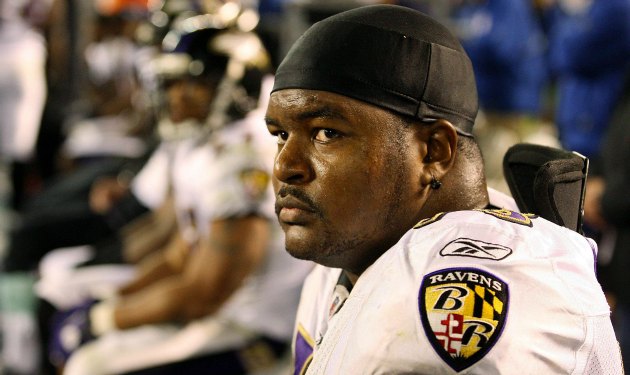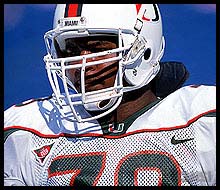By Kevin York
As people look forward to Sundays Super Bowl, there’s been plenty of talk about the skill position players. Joe Flacco. Colin Kaepernick. Ray Rice. Frank Gore. Michael Crabtree. And of course, Ray Lewis’ retirement. There’s a big storyline that many people are missing though, and it’s one that casual fans may not notice.
This Super Bowl matchup features two really, really good offensive lines.
The big guys in the trenches often get overlooked because they don’t score and they don’t tackle. There aren’t a lot of stats to measure them by, at least none that someone watching a game on tv instead of from the press box can keep track of easily.
San Francisco has one of the three best offensive lines in the game, maybe even the best. They’ve largely built it from the ground up through the draft, which is exactly the way I’d do it if I were running a team. I always advocate building a team from the inside out, starting with two strong lines. A good offensive line can make an average quarterback or running back good or a below average quarterback or running back average. Everything starts with the offensive line. You can’t run or pass with any effectiveness unless the big uglies up front are winning their battles.
The 49ers’ Mike Iupati is probably the best guard in the league. Joe Staley is a top five tackle and the other tackle, Anthony Davis, is a top ten tackle. They drafted all three along with Iupati’s counterpart opposite him on the right side of the line, Alex Boone. Only center, eleven year veteran Jonathan Goodwin, was not drafted by the 49ers.
Baltimore’s offensive line is not quite as good as San Francisco’s, and wasn’t as built through the draft, but is also a top ten unit. I don’t know the last time we’ve seen two lines this good in the Super Bowl. We didn’t get it last year. New England and New York deployed solid lines, but they weren’t in the same league as this year’s group. The Packers and Steelers started two injury plagued lines the year prior.
It really is a great story, but the matchup of these two great offensive lines isn’t the story I’m referring to in the title of this post. That story belongs to just one member of the Baltimore Ravens’ offensive line.
When people think about the Ravens’ offensive line, the first name that usually pops in their head is Michael Oher, the big tackle that the book and movie, The Blind Side, were based on. Next is probably guard Marshal Yanda. I mentioned earlier that San Francisco’s Iupati is probably the best guard in the league; Yanda is the other guard in that conversation. Both made my All-Pro team. Once you get past Oher and Yanda, the next name to come up is center Matt Birk, the veteran who was close to retiring last year, but came back another year for a shot to win the big one.
The name that probably doesn’t come up as often is the Ravens’ other tackle, Bryant McKinnie, and for good reason. He reported late to camp, out of shape and overweight. The team cut his salary and he sulked his way through bad practices. He wasn’t a starter at the beginning of the year; he wasn’t even a starter at the end of the year. McKinnie didn’t become a starter for this year’s Ravens team until the wild card round playoff game against the Colts.
What did he do in that game, his first start of the season? McKinnie held Colts pass rusher Dwight Freeney to not only zero sacks, but no tackles at all. None.
Bryant McKinnie began his college football career at Lackawanna College in Scranton, Pennsylvania, where he moved from his high school position of defensive end to offensive tackle. After two years at this junior college, he transferred to the University of Miami for his junior and senior year. As a Hurricane, he was an All-American his junior year and was unanimously selected for the honor again as a senior. He also received the Outland Trophy as the nation’s best interior lineman, was selected as Sports Illustrated’s Player of the Year and finished eighth in the Heisman voting as a senior. That 2001 Miami team also won the national championship.
McKinnie was drafted in the first round of the 2002 NFL draft as a 6’9″ 335 pound senior by the Minnesota Vikings with the seventh overall pick. For the next eight years, the giant tackle was a mainstay on the Vikings’ offensive line, even making the Pro Bowl in 2009. From 2003-2007, McKinnie started every game and had a streak of 80 straight games started. He was a solid NFL tackle and for the most part, lived up to the hype surrounding him coming out of Miami.
In the summer of 2011, his fortunes went south, and due to his own doing. He reported to training camp weighing over 400 pounds; this coming after he finished the previous season at 360 pounds and promised coaches he would get in shape over the summer and drop some weight.
After he was cut by the Vikings, McKinnie was signed by the Baltimore Ravens, largely due to former Miami teammate Ed Reed speaking on his behalf to Baltimore management and vouching for him. He started all 16 games for Baltimore that year, but then at the beginning of 2012, McKinnie’s fortunes again changed as I described earlier with reporting to camp overweight and having his salary cut.
So how did we get to this point? How did McKinnie regain his starting job, in the playoffs no less, and dominate a great pass rusher like Dwight Freeney?
Bryant McKinnie worked his butt off, for one thing. In addition, a string of other things happened along Baltimore’s offensive line that eventually put McKinnie back in a place to step back into a starting role. Ironically, turns out Michael Oher was not as astute at protecting Joe Flacco’s blind side as the movie based on him would seem to indicate. He’s much better playing at the right tackle spot where he can run block. However, during the regular season, the Ravens played Oher at left tackle and rookie Jah Reid at right tackle since McKinnie reported to camp out of shape. When Reid suffered a toe injury, and McKinnie had put together several really good weeks of practice, it led coach John Harbaugh to move Oher back to right tackle, where he played in previous seasons, and start McKinnie at left tackle.
The lineup change ended up paying off for Harbaugh, McKinnie and Baltimore. The big tackle has played well throughout the playoffs and done his part to give Joe Flacco plenty of time to throw the ball downfield, which is exactly what he’s done.
While this matchup of offensive lines is certainly impressive, what’s more impressive is the up and down story of Bryant McKinnie and how he’s worked himself back into a job and helped lead his team to a Super Bowl appearance.
By Kevin York
Follow Kevin on Twitter at @kevin_york
You can contact Kevin at kevin@thecouchletes.com



